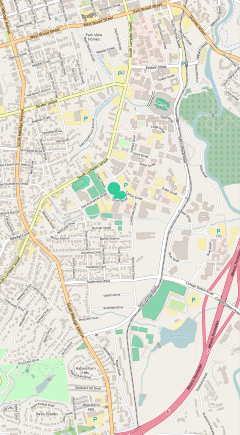Housing at the University of Georgia

Housing at the University of Georgia is managed by the Department of University Housing. On campus housing for undergraduate students is divided into seven communities, and for graduate students into three communities.
Undergraduate housing
Traditional halls
Brumby, Russell, and Creswell halls are collectively known as the "freshman high-rises" due to their similarities in design and function. All three are located just off Baxter Street on West Campus. These are the biggest residence halls on campus and each one of them houses about 1,000 freshmen.
Brumby Community
Brumby Community is a formerly all-female residence hall constructed in 1966.[1] It is nine stories tall and houses approximately 935 students. Rooms are double-occupancy with shared bathrooms, and the community is divided into four colonies: Darien, Newport, Sunbury, and Wentworth.
The Brumby Community, which includes Brumby Hall, is one of three high rise residential communities located on Baxter Street and designated solely to first-year students. Beginning fall 2013 Brumby Hall will be coed with each floor designated as male or female.
The Brumby Community is home to several academic and leadership initiatives. Students of the Franklin College of Arts and Sciences are able to complete academic advising through the Franklin College in the Residence Halls program with one of two advisers assigned to this residence hall, and short courses and seminars are regularly scheduled for the Brumby conference rooms. Brumby Hall's famous rotunda is the site of many events and activities. This residence hall is also home to a satellite office of the Division of Academic Enhancement, which provides tutoring and other academic support services to residents.[2]
Creswell Community
Creswell Community consists of a nine-story residence hall housing approximately 965 students and is divided into four colonies: Frederica, Gordon, Goshen, and Ogeechee. It has double-occupancy rooms with common bathrooms.[3]
The Creswell Community, which includes Creswell Hall, is one of three high-rise residential communities located on Baxter Street and designated solely to first-year students. Creswell is a coeducational residential community for first-year students.
Named after Mary Ethel Creswell, the first woman to receive a degree from the University of Georgia, Creswell Community is home to male and female first-year students. Creswell residents also live near the Bolton Dining Commons.[4]
In 2012, construction on a new University of Georgia dining hall will soon begin at the intersection of Baxter and Lumpkin streets. The building should be open for business by summer 2014. At 55,000 square feet and 950 seats, the new dining hall will be 20,000 square feet larger than Bolton, which has 700 seats.[5]
Russell Community
The Russell Community, which includes Russell Hall, is one of three high-rise residential communities located on Baxter Street designated solely to first-year students. Russell is a coeducational residential community.
Russell Community consists of a ten-story residence hall housing approximately 975 students and is divided into four communities: Augusta, Halifax, Stewart, and Savannah. Prior to the openings of East Campus Village Community, and Building 1516 within Reed Community, it was UGA's newest residence hall despite having opened in the 1960s.[6]
Other traditional halls
Other than the freshman high-rises, UGA residence halls are located in groups known as communities. Each community is composed of four to six residence halls.
Hill Community
Hill Community is made of six residence halls: Boggs, Church, Hill, Lipscomb, and Mell halls, and Oglethorpe House. Hill Community is on West Campus, between the freshman high-rises and Bolton Dining Commons to the west, and the main part of the UGA campus to the east.
Boggs, Church, Hill, Lipscomb and Mell Halls, collectively known as the "lower five", were built in the 1960s and are all four stories, collectively approximately 800 students. Church Hall and Mell Hall are the only all-female hall within the Hill community, the others all being co-ed. The Oglethorpe House, nicknamed "O-House" is nine stories tall and houses residents in suites of two bedrooms and a bathroom. The "O-House" nickname is also applied to the neighboring Oglethorpe Dining Commons despite the lack of "House" in the official name of the dining hall.
Myers Community
Myers Community consists of four residence halls: Mary Lyndon, Myers, Rutherford, and Soule halls. The Myers Community is located on South Campus. The Myers Quad is the space within the four halls of the community, bound by Myers Hall to the west, Mary Lyndon to the south, Soule to the east (across Sanford Drive), and Rutherford to the north.
Soule Hall is all-female, while the other halls are co-educational. Myers Hall is the primary hall for the Honors Program at UGA. Rutherford Hall contains Franklin Residential College. Collectively, Myers Community houses approximately 850 students.
During home football games, the Myers Quad is often used as a central tailgating location. Although the University of Georgia encourages good tailgating practices, tailgaters are often found leaving the Myers Quad as a mess, disrespecting the property. Tailgating at the University of Georgia, and on the Myers Quad has become like a ritual. Tailgaters often setup close to the dormitories found in the Myers Community. [7] The noise and actions from the tailgaters is often bothersome to the highly academic students who reside in the Myers Community.
This community is also just a short walk to Sanford Stadium, the Tate Student Center, and the Coliseum.
Reed Community
Reed Community consists of four residence halls: Morris, Payne, and Reed halls, and building 1516. Unique among UGA's residence hall communities, the halls are not in a single contiguous area. Reed and Payne Halls form the main part of Reed Community, and are located immediately north of Sanford Stadium close to Memorial Hall, Tate Student Center and the Zell B. Miller Learning Center(MLC). Morris Hall is located on Lumpkin Street near Baxter Street and building 1516 is located adjacent to the East Campus Village. Building 1516, opened fall semester 2010, is one of UGA's newest residence hall.
During the summer of 2009, construction began on building 1516 near East Campus Village. The building opened on Monday, Aug. 9, 2010, to more than 550 upperclassmen. The hall has six floors with approximately 550 beds, apartment space, lobby areas, faculty office space and facility shop areas. The structure is a post tension concrete frame with a structural steel framing system for theattic/roof level.
East Campus Village
The East Campus Village (ECV) is made up of four residence halls and collectively houses approximately 1,200 students. It is UGA's newer residential community, having opened in 2004. Residents live in apartments and buildings are co-educational. ECV serves mainly upperclassmen, and is also the designated community for varsity student athletes.
The residence halls of ECV are McWhorter, Rooker, and Vandiver halls, and building 1512. When ECV opened, most of its buildings were only numbered and not named. Building 1512 is still unnamed as of 2010; the other building numbers are 1513 - Rooker, 1514 - Vandiver, and 1515 - McWhorter.
The name McWhorter Hall, prior to ECV's opening, referred to a former residence hall on South Campus, on DW Brooks Drive across from the Driftmier Engineering Center. This residence hall was an all-male dorm housing varsity athletes. The NCAA no longer allows dormitories/residence halls that are exclusive to athletes. This building has since been demolished.
East Campus Village residence halls are completely coeducational, with male and female apartments found throughout all buildings. Residents have the option of paying for cleaning service and have University Housing clean their bathrooms for them. East Campus Village is located near two parking decks, the Ramsey Student Physical Activities Center, the University Health Center, the Performing and Visual Arts Complex and the dining facility and shops of the new East Village Commons. Three of the halls in East Campus Village are rented to students on an 11-1/2 month basis, and one hall is on an academic year basis.[8]
Family & Graduate Housing
Nearly 1,300 graduate students and their families live in one and two-bedroom apartments in one of three on-campus communities: University Village, Rogers Road, and Brandon Oaks. These three communities are located just south of the main part of South Campus and are accessible from East Campus Road.
Health Sciences Campus
The University of Georgia's Health Sciences Campus, located on Prince Avenue in Athens, is a 56-acre campus that was the former site of the U.S. Navy Supply Corps School, which moved to Rhode Island in 2011 as part of the U.S. Department of Defense Base Realignment and Closure process. UGA's use of the property continues the 120-year history of education on the Navy School site. In 1891, the Georgia State Normal School was incorporated on the property, and in 1932, the school became the Coordinate College of the university for women. In 1953, the Navy acquired the site for use as the Supply Corps School. Currently, students from the Georgia Health Sciences University/University of Georgia Medical Partnership, graduate students from the College of Public Health and visiting scholars reside on the Health Sciences Campus.
Beginning in fall 2013, undergraduate students will have the opportunity to live on the Health Sciences Campus in Brown Hall. The Health Sciences Campus is located in Athens on Prince Avenue and Oglethorpe Avenue near Athens Regional Medical Center and the Normaltown area. The campus is served by university and city bus routes as well as UGA Campus Transit.
References
- ↑ http://www.uga.edu/housing/tour/brumby.html
- ↑ "Brumby Community". University of Georgia Housing. Retrieved 8 December 2012.
- ↑ http://www.uga.edu/housing/tour/creswell.html
- ↑ "UGA Creswell Community". UGA Housing. Retrieved 8 December 2012.
- ↑ "UGA reveals location for Bolton Hall cafeteria replacement". Online Athens. Retrieved 8 December 2012.
- ↑ "Russell Community". UGA Housing. UGA Housing. Retrieved 8 December 2012.
- ↑ Fischer, Karin. "A River of Booze". The Chronicle of Higher Education. Retrieved 6 December 2015.
- ↑ "East Campus Community". UGA Housing. Retrieved 8 December 2012.
